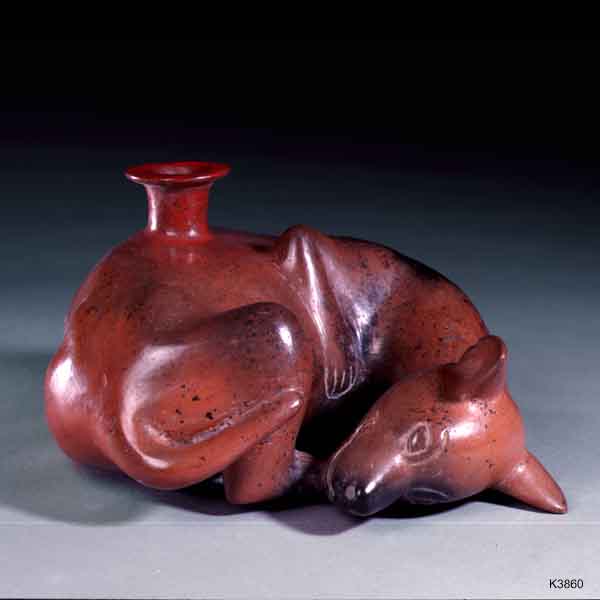
Sleeping Dog
200 BC – AD 250
Colima,
Earthenware
This drinking vessel in the odd shape of a reclining dog possesses an amazing likeness; it is easy to imagine how beloved an object this was to its original owner. A small brown figure lies comfortably on his right side, oblivious to the world and yet of service to his master! The lovingly molded limbs fold gracefully into the shape of the body like the soft fur of a live animal, a minimal artwork in the intensely detailed world of Mesoamerican art. A small stem off of the hindquarters of the modeled creation is the only hint that this darling cutie is not only dead, but he was maybe full of agave beer, too!
A testament to the indigenous Nahuatl peoples of Colima,

Akuaba (Fertility Figure)
Early 20th century
Wood, Glass Beads, String
With a large flat head and a tiny stick body, these figures seem hardly realistic. The low set and close together eyes at first appear distorted, diminished by that gigantic cranium. They are not meant to be adults though! Can you believe it? It’s a sculpture of a baby! The diminished shapes of the eyes and mouth are attached by a thin abstracted triangle of a nose, stark in the shallow spoon of the delicately curving face. Large eyebrows emphasize the expanse of nothingness above the eyes, just as the neck of ridged curves displays the head as truly disembodied.
Women carry the figures on their backs as fertility sign. In the same symbolic system as a local God; they hope to have another child after they have borne their first, and wearing the fertility figure brings good luck. Slung in a pouch across a woman’s back the head of the figure peeks out, giving the silhouette of a child without all the weight! Isn’t that smart? Then the figure can be a simple wooden post with minor carved breasts and two attached pegs for arms. Some wear beading around their ‘waist’ at the base in the style of the






















